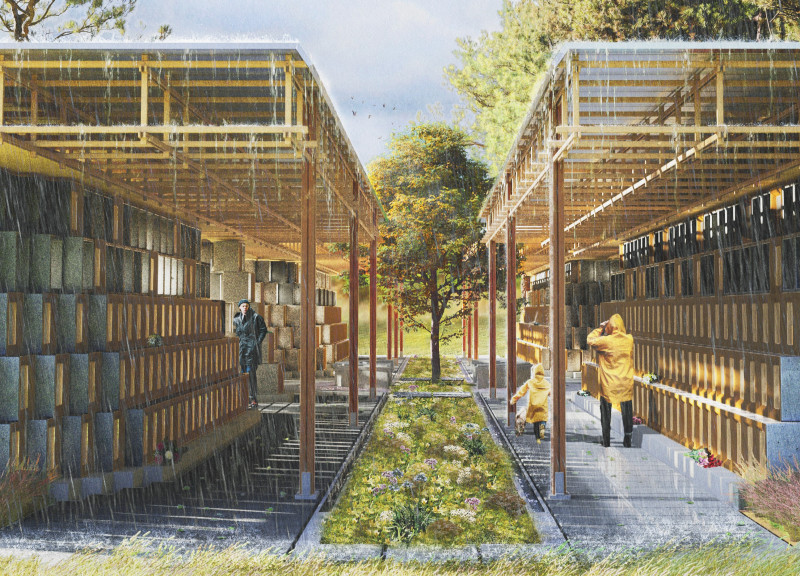5 key facts about this project
Functionally, the project is designed to foster a sense of connection between individuals and nature, creating a harmonious setting for meditation and remembrance. At its core, the design comprises a series of modular structures that facilitate personal memorialization while engaging with the surrounding landscape. These modular elements are interconnected by pathways that encourage exploration and movement through the site, guiding visitors toward meaningful experiences.
The overall design incorporates a circular central courtyard that acts as a focal point for the project. This configuration not only enhances the visual appeal but also promotes a sense of community among visitors, making it a space that is both personal and shared. By allowing visitors to navigate through various open and intimate areas, the design carefully balances privacy with communal reflection, encouraging diverse ways for individuals to honor their connections to others.
Materiality plays a significant role in this architectural endeavor. Concrete is utilized for its structural integrity and durability, forming pathways that anchor the design in its natural context. Timber adds warmth and a tactile quality to the interior and exterior spaces, reinforcing the connection to nature, while glass elements introduce transparency that enhances light penetration, creating a fluid relationship between indoor and outdoor environments. The thoughtful integration of plant materials enriches the ecological dimension of the design, improving biodiversity and promoting an inviting atmosphere.
One of the most distinctive aspects of the project is its modular approach, which allows for adaptability and personalization. Each memorial space can be customized, enabling individuals to express their unique stories and memories within a coherent architectural framework. This flexibility is not only crucial in providing a personal experience but also reflects contemporary attitudes toward memorial practices, making the space accessible and relevant to a broader audience.
The interplay of light is another key design element that defines the experience within "Through Light." By using strategically placed glass sections and openings, the design ensures that natural light floods the spaces throughout the day, creating dynamic patterns and shadows that change with the sun’s movement. This thoughtful use of light elevates the design, fostering introspection and enhancing the emotional resonance of the environment.
In terms of ecological considerations, the project demonstrates a commitment to sustainability by incorporating local materials and water management strategies. This not only reduces the environmental footprint but also contributes to the creation of a site that feels integral to its surroundings. The emphasis on accessibility throughout the design ensures that all individuals can participate in the reflective experiences offered, reinforcing the welcoming intention behind the architectural choices.
Through its thoughtful exploration of space, light, materials, and personal expression, "Through Light" stands as a meaningful architectural project that resonates with its users. The interplay between the natural and built environments encourages visitors to engage in a reflective journey that honors both life and loss. Those interested in uncovering further insights into this project are encouraged to explore the architectural plans, sections, and designs to gain a fuller understanding of its intent and impact.


























